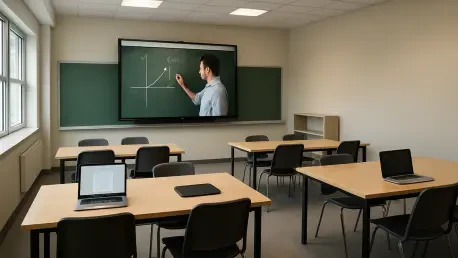Imagine a world where students no longer sit through lengthy lectures in a classroom, passively absorbing information, but instead engage with lessons at home through dynamic digital platforms, arriving at school ready to dive into hands-on problem-solving and collaborative projects. This is the essence of the flipped classroom model, an innovative educational approach that reverses traditional teaching by prioritizing active learning over rote instruction. As technology continues to evolve and the demand for personalized education grows, this model is gaining momentum across K-12 schools, universities, and even corporate training programs. With projections estimating the market to expand from USD 2.7 billion currently to USD 12.1 billion by 2035, at a compound annual growth rate (CAGR) of 16.2%, the potential for transformation is staggering. This remarkable growth signals a global shift toward student-centered learning, raising critical questions about how this approach will redefine the educational landscape over the next decade.
Current Trends and Market Growth
Driving Forces Behind Adoption
The flipped classroom market is experiencing an unprecedented surge, driven by a confluence of societal needs and technological possibilities. Current estimates place the market at USD 2.7 billion, with a trajectory to reach USD 12.1 billion by 2035, reflecting a robust CAGR of 16.2%. This rapid expansion is fueled by a growing recognition of the limitations of traditional education, where one-size-fits-all lectures often fail to address individual learning styles. The flipped model counters this by allowing students to engage with instructional content at their own pace outside of class, while in-person sessions focus on deepening understanding through interactive activities. Beyond academic settings, industries are adopting this framework for employee training, recognizing its efficiency in skill development. This widespread interest underscores a broader push for educational innovation, positioning flipped classrooms as a cornerstone of modern learning strategies across diverse sectors.
Another key driver is the increasing demand for tailored educational experiences that cater to unique student needs. Unlike conventional methods where time constraints limit personalization, the flipped approach empowers learners to revisit materials as often as necessary, ensuring comprehension before moving forward. In-class time then transforms into a space for targeted discussions, problem-solving, and peer collaboration, fostering critical thinking over memorization. This shift aligns with global educational goals to improve outcomes by prioritizing engagement and adaptability. Furthermore, the model’s ability to integrate seamlessly with digital tools amplifies its appeal, as educators can leverage data analytics to monitor progress and adjust teaching methods accordingly. As this demand for individualized learning continues to grow, flipped classrooms are set to play a pivotal role in shaping future curricula and training programs worldwide.
Regional Adoption Patterns
Regional disparities in the adoption of flipped classrooms highlight both opportunities and challenges on a global scale. North America and Europe currently lead the way, benefiting from advanced digital infrastructure and a strong emphasis on pedagogical research. These regions have integrated the model into mainstream education, with schools and universities focusing on enhancing student engagement through innovative teaching practices. The availability of high-speed internet and widespread access to devices has facilitated seamless implementation, allowing educators to experiment with interactive content and real-time feedback mechanisms. While growth in these areas remains steady, the focus is shifting toward refining existing systems and ensuring that the benefits of flipped learning are equitably distributed across urban and rural institutions, addressing any lingering access gaps.
In contrast, the Asia-Pacific region emerges as a powerhouse of growth, driven by rapid digitization and significant government support for educational technology. Countries like China and India, with their vast student populations, are witnessing an explosion of interest in flipped classrooms, supported by initiatives to expand internet connectivity and provide affordable devices. This region’s tech-savvy youth and cultural emphasis on academic achievement create fertile ground for the model’s adoption, particularly through mobile learning apps and online platforms. Meanwhile, Latin America, the Middle East, and Africa show slower progress due to infrastructural constraints, though urban centers are beginning to adopt the approach as connectivity improves. These emerging markets hold immense potential for expansion by 2035, provided investments in digital infrastructure continue to bridge existing divides and make flipped learning accessible to a broader audience.
Technological Innovations and Challenges
Enhancing Learning Through Digital Tools
Technology serves as the backbone of the flipped classroom model, enabling its core principle of delivering content outside traditional settings while maximizing in-class interaction. Digital platforms, equipped with AI-driven analytics, allow for personalized learning experiences by tracking student progress and identifying areas for improvement in real time. Interactive tools such as gamified quizzes and virtual labs further enhance engagement, transforming passive content consumption into an active, immersive process. These advancements ensure that students can learn at their own pace, revisiting complex topics as needed, while educators gain valuable insights to tailor their in-class activities. The scalability of these technologies also means that flipped classrooms can reach diverse populations, from rural schools to global corporate training programs, making education more inclusive and adaptable to varying needs.
Moreover, the continuous evolution of mobile-accessible solutions is breaking down barriers to implementation, particularly in regions where smartphones outnumber traditional computers. Mobile apps designed for flipped learning provide on-the-go access to pre-recorded lectures and supplementary materials, ensuring that students can engage with content anytime, anywhere. This flexibility is complemented by advancements in cloud-based learning management systems, which streamline content delivery and facilitate collaboration through shared resources and discussion forums. However, the effectiveness of these tools hinges on their design—ensuring they are user-friendly and compatible with a range of devices is critical to their success. As technology continues to advance, the integration of more sophisticated features, like virtual reality simulations, could further elevate the flipped classroom experience by 2035, offering even deeper levels of interaction and understanding.
Barriers to Widespread Implementation
Despite the promise of flipped classrooms, significant challenges threaten to hinder their global adoption if not addressed strategically. Infrastructure limitations stand out as a primary barrier, particularly in developing regions where reliable internet access and digital devices remain scarce. Many schools struggle to provide the basic tools needed for students to engage with online content outside of class, exacerbating educational inequities. This digital divide means that while urban centers may benefit from flipped learning, rural and underserved areas risk being left behind, widening the gap in academic outcomes. Overcoming this hurdle requires coordinated efforts from governments, private sectors, and educational institutions to invest in connectivity and affordable technology, ensuring that the benefits of this model are not confined to privileged regions.
Equally critical is the need for comprehensive teacher training to ensure the flipped model is implemented effectively. Educators must be equipped not only with technical skills to navigate digital platforms but also with pedagogical strategies to facilitate interactive, student-centered learning environments. Without proper support, there is a risk that in-class time could devolve into unstructured activities rather than meaningful engagement. Additionally, maintaining student motivation for self-paced learning outside the classroom presents a persistent challenge, as not all learners possess the discipline required to complete pre-class materials independently. Innovative approaches, such as incorporating rewards or real-time progress tracking, could help sustain interest. Addressing these barriers—through professional development and student support systems—will be essential to realizing the full potential of flipped classrooms over the next decade.
Future Outlook and Applications
Beyond Traditional Education
The versatility of the flipped classroom model extends far beyond K-12 schools and universities, finding increasing relevance in corporate training environments. Companies are recognizing the efficiency of this approach in delivering complex, skill-based content to employees, reducing training time while improving knowledge retention. By allowing workers to engage with instructional materials at their convenience, organizations can focus in-person sessions on practical applications, simulations, and team-building exercises that reinforce learning. This adaptability makes the model particularly valuable in industries undergoing rapid technological change, where continuous upskilling is essential. As businesses strive to remain competitive, the flipped approach offers a scalable solution to prepare workforces for evolving demands, highlighting its potential to reshape learning across diverse sectors by 2035.
Furthermore, the application of flipped classrooms in professional development underscores a broader shift toward lifelong learning, where education is no longer confined to early life stages. Adult learners, often balancing work and personal commitments, benefit from the flexibility of accessing content on their own schedules, while interactive group sessions provide opportunities for networking and practical problem-solving. This model also supports the integration of micro-credentials and short-term certifications, allowing individuals to acquire targeted skills without committing to lengthy programs. As industries and educational providers collaborate to create tailored content, the flipped classroom could become a standard for professional growth, bridging the gap between academic theory and real-world application. This expansion into non-traditional settings signals a profound transformation in how knowledge is imparted and acquired globally.
Paving the Way Forward
Looking ahead to 2035, strategic investments in affordable educational technology will be crucial for scaling flipped classrooms on a global level. Developing cost-effective tools and mobile-accessible platforms can help democratize access, particularly in regions where financial constraints limit adoption. Stakeholders, including governments and private entities, must prioritize initiatives that bridge the digital divide, ensuring that students and educators in underserved areas are not excluded from the benefits of this transformative model. Collaborations between tech companies and educational institutions could drive the creation of localized content, addressing cultural and linguistic barriers while maintaining quality. Such efforts will be instrumental in making flipped learning a universal standard, reshaping education to be more inclusive and responsive to diverse needs.
In parallel, a sustained focus on educator support and professional development is vital to overcoming implementation challenges. Training programs should emphasize both technological proficiency and the facilitation of active learning environments, empowering teachers to maximize the impact of in-class time. Additionally, fostering student engagement through innovative incentives and real-time feedback mechanisms can address motivation issues associated with self-paced learning. As these strategies take shape, continuous evaluation and adaptation of flipped classroom practices will be necessary to align with emerging technologies and learner expectations. By committing to accessibility, quality, and support, the educational landscape can evolve into a more equitable and impactful system, ensuring that the promise of flipped learning is realized for generations to come by 2035.









